Services on Demand
Journal
Article
Indicators
-
 Cited by SciELO
Cited by SciELO -
 Access statistics
Access statistics
Related links
-
 Cited by Google
Cited by Google -
 Similars in
SciELO
Similars in
SciELO -
 Similars in Google
Similars in Google
Share
Ingeniería y Universidad
Print version ISSN 0123-2126
Ing. Univ. vol.17 no.2 Bogotá July/Dec. 2013
Semantic enrichment and inference of relationships in an online social network1
Enriquecimiento semántico e inferencia de relaciones en una red social en línea2
Enriquecimento semântico e inferência de relações em uma rede social online3
Emmanuel Gerardo Lasso-Sambony4
Sandra Marcela Ortega-Ponce5
Juan Carlos Corrales6
1Received: December 3, 2012. Accepted: May 27, 2013. This Article is a result of the research project Inference of relationships between entities in an online social network, developed by the Telematics Engineering Group of the University of Cauca, Popayán, Colombia. Special thanks to University of Cauca, Diego López PhD in Biomendical Sciences and Nilton Obando M.Sc. Student for supporting this research approach.
2Fecha de recepción: 3 de diciembre de 2012. Fecha de aceptación: 27 de mayo de 2013. Este artículo se deriva del proyecto de investigación Inference of relationships between entities in an online social network, desarrollado por el Grupo de Ingeniería Telemática de la Universidad del Cauca, Popayán, Colombia.
3Data de recebimento: 3 de dezembro de 2012. Data de aceitação: 27 de maio de 2013. Este artigo é derivado do projeto de pesquisa Inference of relationships between entities in an online social network, desenvolvido pelo Grupo de Engenharia Telemática da Universidad del Cauca, Popayán, Colômbia.
4Engineer in Electronics and Telecommunications. Researcher in Telematics Engineering Group of the Universidad del Cauca. Popayan, Colombia. email: eglasso@unicauca.edu.co.
5Engineer in Electronics and Telecommunications. Researcher in Telematics Engineering Group of the Universidad del Cauca. Popayan, Colombia. email: sortega@unicauca.edu.co.
6Ph.D. in Computer Science. Professor at the Department of Telematics of the Universidad del Cauca, Colombia. email: jcorral@unicauca.edu.co.
Abstract
The relationships among users in an online social network helps to build a graph that represents the structure. In turn, the semantic enrichment of connections between users provides a higher level of meaning to these relationships, which is an advantage when modeling the internal behavior of a social network. Several researches argue that the use of ontologies in the modeling of social networks, makes that the inference of information on the relationship between users is not inconsistent. However, several authors do not consider the various types of relationships implicitly present in an online social networking. So, in order to overcome the problems posed, in this article we propose a tool that aims to generate a representation of an online social network taking into account the semantic enrichment and the inference of new relationships between users. The prototype assessment made reveals satisfactory results with respect to the inference of new relationships and the accuracy of the associated recommendation system, in this way, it is possible to get a closer representation to the reality of the existing connections in an online social networking.
Keywords: Relationships, enrichment, semantic, inference, networking, social.
Resumen
Las relaciones entre los usuarios de una red social en línea permiten construir un grafo que representa su estructura. A su vez, el enriquecimiento semántico de las conexiones entre los usuarios brinda un mayor nivel de significado a estas relaciones, lo cual supone una ventaja a la hora de modelar el comportamiento interno de una red social. Diversas investigaciones argumentan que el uso de ontologías en el modela-miento de redes sociales, contribuye a que la inferencia de información sobre las relaciones entre usuarios no sea inconsistente. Sin embargo, varios autores no consideran los diversos tipos de relaciones presentes implícitamente en una red social en línea. Así, con el fin de superar los problemas planteados, en el presente artículo se propone una herramienta que tiene como objetivo generar una representación de una red social en línea considerando el enriquecimiento semántico y la inferencia de nuevas relaciones entre sus usuarios. La evaluación realizada al prototipo evidencia resultados satisfactorios respecto a la inferencia de nuevas relaciones y la precisión del sistema de recomendación asociado; de esta manera, es posible obtener una representación más cercana a la realidad de las conexiones existentes en una red social en línea.
Palabras clave: Relaciones, enriquecimiento, semántica, inferencia, red, social.
Resumo
Os relacionamentos entre usuários de uma rede social online permitem construir um grafo que representa a sua estrutura. Por sua vez, o enriquecimento semântico das conexões entre usuários proporciona um nível de significado mais elevado a esses relacionamentos, o que é vantagem na hora de modelar o desempenho interno de uma rede social. Diversas pesquisas argumentam que a utilização de ontologias na modelagem de redes sociais, contribui para que a inferência de informação sobre os relacionamentos entre usuários no sejam inconsistentes. No entanto, vários autores não consideram os diversos tipos de relacionamentos presentes implicitamente em uma rede social online. Assim, com o objetivo de superar os problemas esboçados, propõe-se no presente artigo ferramenta que tem o objetivo de gerar uma representação de uma rede social online considerando o enriquecimento semântico e a inferência de novos relacionamentos entre os usuários. A avaliação feita ao protótipo evidencia resultados satisfatórios em relação à inferência de novos relacionamentos e a precisão do sistema de recomendações associado; desta forma é possível obter uma representação mais próxima da realidade das conexões existentes em uma rede social online.
Palavras-chave: Relações, enriquecimento, semântica, inferência, rede, social.
1. Introduction
Internet is a very popular and useful media of great impact worldwide, which is in a constant and rapid change due the introduction of new technologies. One result of this evolution is the emergence of online social networks, which are positioned as a new technological and social phenomenon to exchange knowledge, experiences and resources among individuals, groups and institutions in various contexts (Caldevilla, 2010) (Tenzer, et al., 2009). In other words, social networks can be defined as a specific set of actors (individuals, groups, organizations, communities, etc.) linked to one another through a relation or group of relations (Lozares, 1996), therefore, the behavior of these actors and their relationships determine the structure of the network to which they belong. Over time, individuals create and deactivate initially identified social ties, thereby altering the structure of the networks involved (Kossinets and Watts, 2006).
Although the spaces dedicated to online socialization provide the ability to build relationships between users, the ability to specify the diversity of these relationships more broadly is limited. Such diversity is a common phenomenon in real socialization process, especially due to: different areas in which two people can relate and varied behavior within the network (Carton and Wellman, 1999). Also, there are certain cases in which the relationships have not been established between two users should be taken into account, due to the importance of maintaining active communication between members of a network, which perform functions and activities in a common domain. The above expresses the need to incorporate inference process in order to establish and provide additional connections between two users.
This paper proposes a solution to the mentioned need previously, through a tool that allows expressing and inferring the different relationships between users in an online social network, integrated into a Social Network Service.
The paper is structured in the following way. In Section 2 are presented related works, the strategy of semantic enrichment of relationships between users and the addition of semantic enrichment and inference techniques to the social networking platform. Section 3 describes the prototype developed and the results obtained after performing experimental evaluation. Finally, Section 4 gives some conclusions and future work.
2. Materials y methods
2.1. Related work
Nowadays, social networks are known by most people in the world, and have been associated basically with the world of the Internet; however, the study area of social media is far more extended and involves important concepts that facilitate understand the dynamics of human behavior in a community.
The general concept of a network in any application domain (transit, water and sewage, electricity, etc.) indicates that consists of nodes and connections. Now, a social network consists of a finite set of actors and relations between them (Wasserman and Faust, 1994). If we instantiate the general definition of a network to a social network, we could say that the nodes represent entities (authors, words, web pages, etc.) and connections express the relationships between the various entities (joint publication or collaboration, referral, friendship, among others) (de la Rosa, et al., 2005), finding their computer representation in online social networks, which allow individuals to construct a profile within a bounded system, articulate a list of other users with whom they share a connection, and traverse their list of connections and those made by others within the system (Ellison, 2007). The graph-based formal representation is used by social networks as their way of description because it allow characterizing its structure, the strategic positions of its elements, specific sub-networks and activities carried out by individuals (Scott, et al., 2000). Due to the introduction of semantics in social networks, there is a new graph concept called "semantic graph", consisting of classes of an ontology (nodes) and the relationships between them (connections), representing semantic structures (Rowe, 2009 ). In the domain of social networks, ontologies are used to model the different social entities (people, organizations, etc.), in the case of individuals, ontologies are used for modeling their profile and their interactions with other social entities in the network (Wennerberg, 2005) (Erétéo, et al., 2010). The semantic enrichment of these interactions can be applied, for example, to the messages shared through social networks dedicated to microblogging like Twitter (Celik, et al., 2011). Another case is presented in the possibility of enrich semantically location data of individuals with an associated date, in order to generate "life patterns" (Doyts-her, 2010). Furthermore, the inclusion of semantics to describe the structure of the network allows the implementation of inference process that generate new data on the network, such as building implicit trust networks for a recommendation system (Martín-Vicente, et al., 2012) and the discovery of friendly relations based on relations existing between users and their interaction with content (Zhou, et al., 2010). Table 1 displays the state of the art analysis that supports this research, highlighting the gaps that facilitate the identification of the problem to be treated.
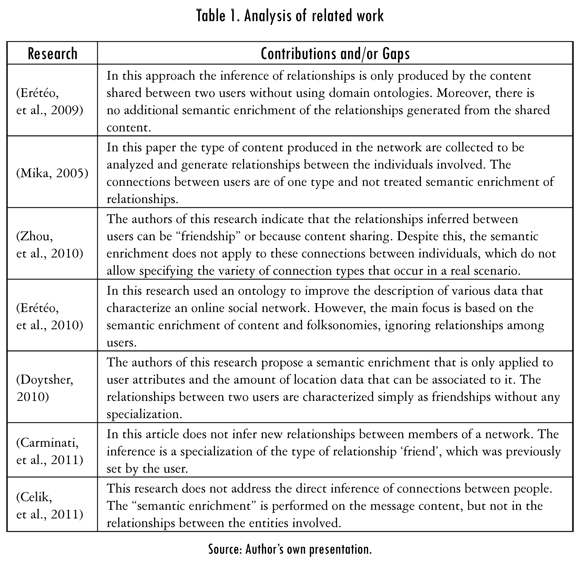
From the above, and considering that the emergence of Social Web sites, social network services created and the information generated by them are in constant growth, with the need to establish interoperability between these data sources (Bojars, et al., 2008) (Kim, et al., 2010); in this paper we propose a novel approach to inferring relationships among members of a social network, based on existing relationships, using the semantic enrichment of user data and their relationships. Is important to consider that the relations between users can be of various types, such as family, work, collaborative, etc., which describes the different environments where two people can relate to. Finally, it is worth noting that from this approach is feasible in a future building recommendation systems based on the user's social behavior.
2.2. Semantic enrichment of user's relationships
This section describes the required elements for the semantic enrichment relations between users in a social network online. Initially, we present our ontology for semantic enrichment; also exemplifies the use of these ontologies in the representation of social data (profile, relationships) through the generation of a semantic social graph. Finally, is presented the storage and querying of this graph.
2.2.1. Domain ontologies for semantic enrichment
Ontologies are a formal classification scheme whose concepts, properties and relations can be associated with social data through semantic tags, providing a higher level of data meaning. The purpose of including ontologies in social networks is focused on formally describe the data associated with both, the users profile and their social relationships. The foregoing allows to enrich semantically the user graph information, expressing the data in terms of standard languages such as RDF (Resource Description Framework).
In this paper are considered five ontologies to model the user profile and its interaction with other social institutions. These are: FOAF (Friend of a Friend), a vocabulary quite simple and pragmatic, which allows joining information networks with networks of people through the web. BIO (Biographical Information), consisting of a core of classes and properties for describing biographical events, genealogical information of people and some types of relationships. Relationship is a vocabulary for describing relationships between people, which extends the property "knows" of "FOAF" and specializes it in various types of relationships. Family, an ontology whose classes and properties describe simple family relationships, with a higher level of expertise that other ontologies. Finally we have Organization, an ontology that describes the structure of an organization, roles, relationships between people and their activities using basic terminology.
The enrichment of the user's personal data (name, date of birth, email, etc) uses FOAF and BIO, as presented in Table 2.
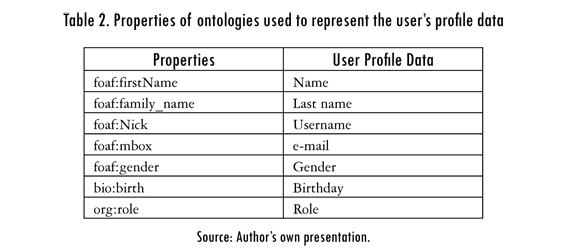
Moreover, Relationship, Family and Organization provide a set of terms that allow describing user relationships with other users and affiliation in a particular organization (see Table 3).
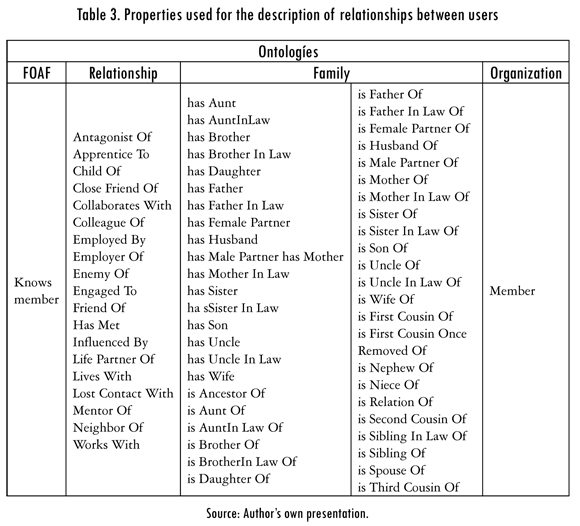
2.2.2. Representation of social data using ontologies.
Online social networks capture the user information and store it in databases. The recovery of such data can be performed from any application using SQL queries, designed to extract data from the user profile and social interaction.
That is how from social interactions you obtain the graph of the network, adopted as a representation of social networks and considered the core of online social networks (Pallis, et al., 2011). The graph is expressed by G = (V, E), where V denotes a finite set of nodes connected by direct links or vertices E, such that E ⊆ Í V x V correspond to relationships, as seen in figure 1.
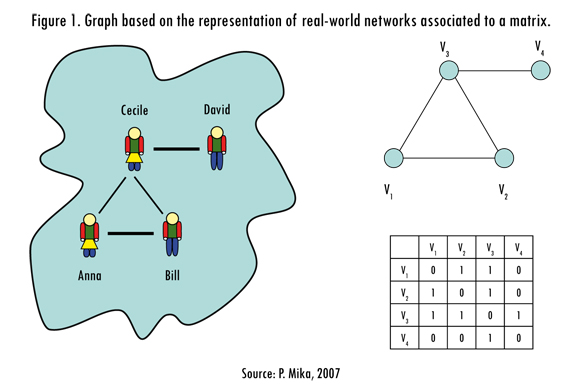
Graphs are a graphical representation of the social network that models the information of its members. However, this representation is only worried about the syntax and not the semantics. This latter allows enriching and generating additional information from the data present in the network. For this reason, it is important to use ontologies to structure and describe social data of an online social network in terms of specialized vocabularies for a specific domain. Accordingly, in this work, to enrich the users' social data, should be carried out the process described in Figure 2. This process starts when the data captured by the social network (profile data and user relationships) are extracted from the database through SQL queries and are arranged to form the user graph. Sub-sequently, the data in the graph are associated with the concepts of ontologies in order to enrich them semantically. In this way an enriched graph is obtained where the data acquire structure.

It is noteworthy that the graph we have considered in this work is a directed graph (Harary, et al., 1965), so the establishment of a new connection by a user does not involve the generation of the inverse automatically.
2.2.3. Storage and query of the network graph
Our knowledge base corresponds to a set of graphs that describe certain characteristics of the network. These graphs are stored and accessed from a "Triple Store". These graphs are:
- Stable enriched graph: contains all the network structure, the relationships established and the inferences accepted by users.
- Inference graph: contains suggestions of relationships generated in the process of inference.
- Accepted relations graph: contains the inferences that users have accepted. This information is used to avoid generating inferences already accepted.
- Rejected relationship graph: contains the inferences that users have rejected. This information is used to avoid generating inferences already rejected.
The information provided by these graphs could be accessed by any application via the Web using an "Endpoint" and making use of SPARQL language.
2.3. Incorporation of semantic enrichment and inference techniques to the social networking platform
2.3.1. Reasoning and inference rules
In a social network, the use of reasoners and inference rules allows to exploit data semantically enriched in the graph of the network, in order to obtain additional information (information inferred from the current data). Consequently are of interest in this paper two techniques of reasoning; the first, called ontology-based reasoning, and the second, called rule-based reasoning.
In ontology-based reasoning, the graph of the network is linked to a reasoner that incorporates domain vocabulary with the goal of getting implicit information, product from the semantics of the ontology. In Figure 3 can be appreciated the result of this reasoning, where the enriched graph before the reasoning contains three nodes, which are related as follows: "ccaicedo has as mother anama" and "ccaicedo is brother of pedroc "; the new relationships obtained after reasoning (without applying any rule of inference) correspond to a portion of the relationships described by the ontology" Family ".
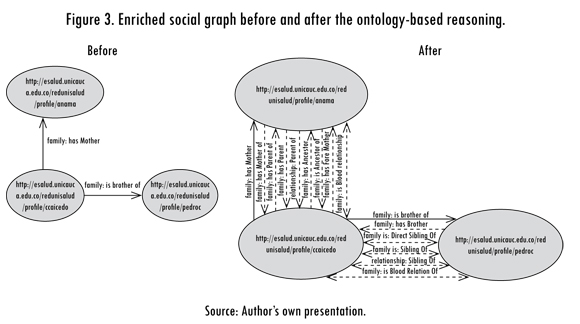
Meanwhile, in the rule-based reasoning, the enriched graph together with inference rules are linked to the reasoner to infer a set of data, based on the logic of the rules. In this paper is used the model of rules specified in the framework for developing semantic applications Jena (Apache Jena, 2012). These rules contain an antecedent (clause "if") and a conclusion (clause "then"). The antecedent contains four premises separated by commas. In each premise the variables are preceded by a "?", similar to as used in SPARQL; if the four premises are true, the corresponding triple of the conclusion is added to the model inferences. An arrow (→) separates the antecedent of the body; in this case the direction of the chaining is forward, if the arrow is reversed (←) the direction of chaining is backward. Below is presented an example of the rules used:
[rule21: (?w relationship2: livesWith ?x), (?x relationship2: livesWhit ?z), notEqual(?w, ?z) — (?w relationship2: livesWith ?z)]
In the previous rule (rule21) we consider three persons: x, w, and z. In the event that "w" live with "x" and "x" live with "z", the rule verifies that "w" is not equal to "z", so as to conclude that "w" lives with "x".
In the figure 4 can be seen the result of this reasoning. The dotted lines represent the inferred relationships. In total 18 new relationships were obtained from 20 initially present, where the system applied 7 rules of inference related to the ontology "Relationship" and 6 rules related to "Family".
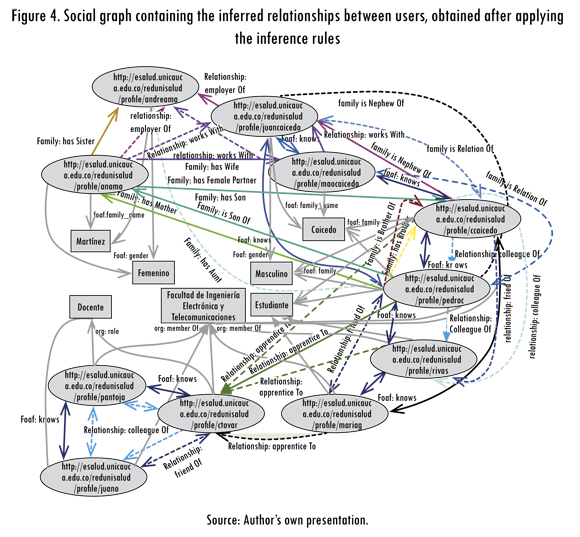
2.3.2. Incorporation of semantic enrichment results and inference of relationships into a social networking platform
The use of social networking platforms allows the complete customization and development of a website for these communities. Elgg (Elgg, 2012) has been the chosen platform for this work, which, in its initial installation has several services related to social interaction and provides, in addition, an API that supports the development of additional functionalities. Set out below are the adaptations to the Elgg platform in order to support the semantic enrichment and inference of relationships between users:
- data visualization of semantically enriched user profile (consulted from the knowledge base).
- aggregation of user profile fields related to the ontologies used (stored in the knowledge base).
- a form for the establishment of different types of relationships between a user and his contacts in the network. These types of relationships are extracted from the concepts of the ontologies "Relationship" and "Family".
- presentation of the inferred relationships for each user, extracted from the result of the reasoning applied to the network. In addition, next to each inference are the options to accept or reject the suggestion.
- rejected suggestions section with their respective option to accept.
- summary of the relationships involving each user and have been established both by the user or by other network members.
- information about types of relationships established and relationships suggestions in the profile of each user as customizable widgets.
2.3.3. Triple Store
To comply with the performance characteristics of the system (such as that discussed in section 2.2.3), it is necessary that the persistence is divided into four main graphs representing the knowledge base. Therefore, in the Triple Store are configured the same number of Endpoints that provide access and storage of graphs.
- inferred_ep: contains the graph of suggested relationships, product of the inference process.
- accepted_ep: stores the suggestions that have been accepted by users.
- descarted_ep: stores the suggestions that have been rejected by users.
- modeldataep: in this Endpoint is located the stable social graph. Contains the network structure semantically enriched, inferences accepted by users and relationships that users have added manually.
Access to these Endpoints is given both from the SEPlugin, and from JAVA application that handles inferences and semantic enrichment.
3. Experimentation
3.1. Prototype
The prototype is made up by two parts. "SEPlugin", which is an add-on developed for the Elgg social networking platform, whose function is to display enriched social data and the relationships inferred by the semantic application. Simultaneously, allows adding relationships with other users, according to the concepts in the ontologies "Family" and "Relationship". SEPlugin is developed in PHP, according to the structure that Elgg team have set for the platform extensions. For its part, the application semantics, called "SemanticApp" is developed in the Java Programming Language and is responsible for integrate the ontologies of social behavior and reasoning techniques to user data and their interactions; this is done with the aim to enrich semantically and infer new relationships between users. For this reason, the application includes the Jena framework, which facilitates the use of semantic tools and access to information of graphs stored in the knowledge base. Figure 5 shows the architecture of the prototype, which highlights the following modules:
- Obtaining and semantic enrichment of user data: this module is responsible for mapping the profile data and friendships own of the Elgg platform, in order to enrich semantically through some concepts of ontologies and transform them into a graph.
- Reasoning over the social graph: the function of this module is to make the process of inference on data obtained in the graph of the above module. The inference process is performed according to the relationships that the user has added recently in the network, the information is stored in a control database.
- Refinement of results: has the responsibility to verify the results of the inference process and compare them with the information of graphs stored in the knowledge base, in order to present the best possible suggestions.
- SEPlugin: This plugin integrated into Elgg platform, represents the only way of user interaction with the system. Therefore, it is responsible for processing requests and presenting the data in the different interfaces.
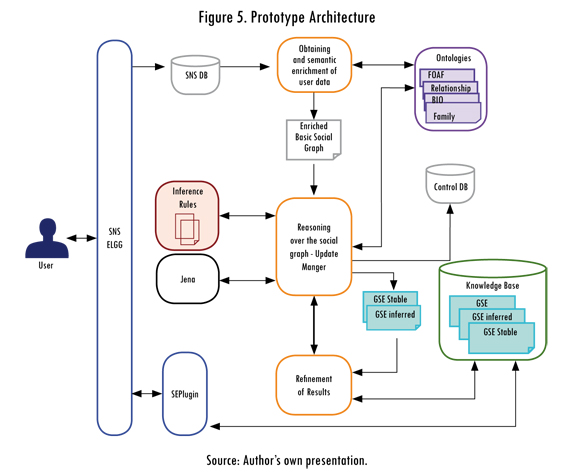
Additionally, the prototype keeps track of user activity with respect to the types of relationships added and inferences accepted or rejected. With this register, the inference process executes only rules which involve types of relationships that have been added recently on the network, this in order to minimize the execution time.
3.2. Case study
In order to respond to a real requirement, the prototype was implemented in the Social Network of Health Unit of the Universidad del Cauca (Red Unidad de Salud, 2012), where it is still running. In this network there was a need to express the different environments in which two people can relate to (family, work, academic and several relationships) with the aim to obtain a representation of the network closer to reality. In this regard, the developed prototype allowed verifying that the semantic enrichment and inference of relationships express smugly behavioral dynamics in an online social network. It is worth noting that the suggestion of such relations was possible thanks to the plugin of recommendation created.
3.3. Results
With the aim to ensure proper experimentation using the prototype developed, first, was stored the original graph (without semantic enrichment) to know the initial state of the network. At the end of the experimentation period, was generated a new graph of the network (end state), which includes the different types of relationships established by users, as well as rejected and accepted inferences through the plug-in. This two graphs of the network, initial state and end state, should reflect the ability of the system to express the multiple relationships that can be presented between two users according to the domain in which the members of the network operate. The comparison of the two network graphs also shows the new connections between users discovered through our system. Furthermore, the effectiveness of the inferences generated by the system is the result of comparing the number of suggestions accepted with the number of rejected suggestions. Table 4 presents the test plan execution. Below we present the most relevant results.
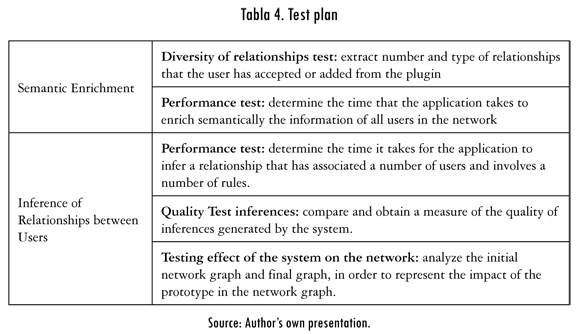
The server where the prototype was deployed has the following features: Processor: Intel ® Core™ 2 Duo, 2.67 GHz, RAM: 4 GB dual-channel DDR3 SDRAM at 1333 MHz, 160 GB HDD at 7200 RPM and Debian OS 6.0.4.
In the test of diversity of relationships obtained an increase of 1 type of relationship that have Elgg (friendship) to 17 types of relationships specified at the end of the experimentation time (Figure 6).
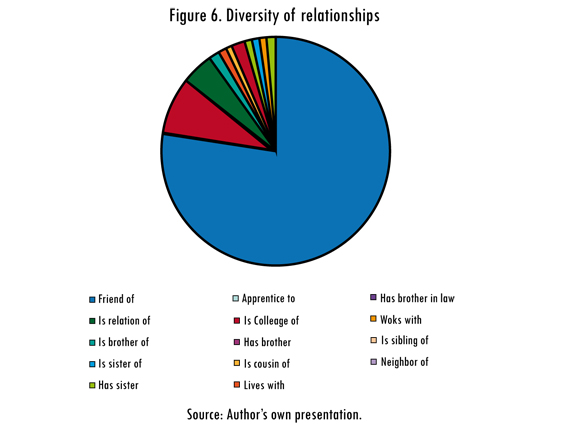
For its part, the performance tests report an increase in execution time of semantic enrichment and inference process. This is due to the different numbers of triples to be processed depends on the recent activity of the network, the number of users and their dynamics in establishing new relationships.
The algorithm complexity of the system can be analyzed from its two components: the semantic enrichment and inference. The first has a complexity O(n) and the second has a complexity O(n2), where n represents the number of triples to be processed. The linear complexity of the semantic enrichment indicates a runtime increase directly proportional to the number of triples to be processed. Moreover, the quadratic complexity of the inference shows an increase in quadratic order, where for each two triple, time increases four units. For the inference component was taken into account the analysis performed by Charles Forgy (Forgy, 1979) about the complexity of RETE algorithm, implemented by the Jena Framework for reasoning.
Quality testing of inferences generated is presented in Figure 7. This test shows quality inferences with 89% accepted and 11% rejected, where relationships "friend" and "works with" are the most rejected.
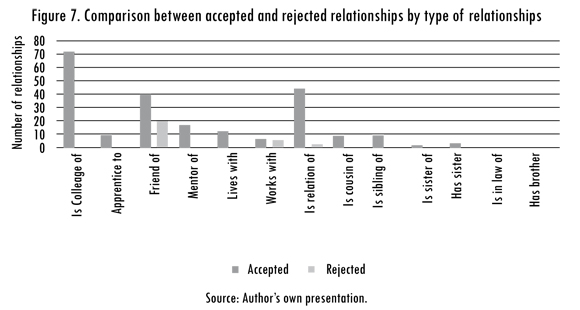
4. Conclusions
In this research it has been addressed the need to express in a way closer to reality the dynamic of user behavior starting from their relationships in a Social Network Online. Initially, research focused on ontologies of social behavior for semantic enrichment of relationships between users. It is important to constantly check for changes in the network structure, since this way the social graph generated keeps consistency with the actual network activity. The inclusion of ontologies in social networks allowed us to formally describe the data associated with the structure of these networks. Thanks to this, it is obtained a semantic enrichment of social graph that allows characterizing the links established between users with a variety of concepts, reflecting the different scenarios in which they relate. Their study enables progress towards the inference of relationships, emphasizing the use of reasoners and inference rules that exploit the rich data of a social network, in order to obtain new information starting from existing information. With the integration of these elements, the final step is to incorporate them into a social networking platform in order to provide users of that network an interaction with the information generated by the system. From this interaction, we obtain several measures to evaluate the performance of the prototype, highlighting the diversity of relationships present after its application and acceptable quality of the suggestions generated. For higher quality inferences should be taken into account a lot of variables of human behavior (relationships, interactions, location, likes, etc.). In relationships based reasoning is expected a margin of error, because the links between people represent only a portion of these variables.
On the other hand, the time required to run the system tends to grow as the number of users and their relationships, which would be a drawback for large networks.
As future work is proposed to increase the data enriched of user profile and incorporate more ontologies, decrease the time of the inference process, increase the variables considered for the inference, consider the lifetime of a relationship and implement access control interface to the relationships established.
References
APÃCHE JENA [documento en línea]. http://jena.apache.org/. [consulta: 14-11-2012] [ Links ]
BOJARS, U.; BRESLIN, J. G.; PERISTERAS, V, et al. Interlinking the social web with semantics. Intelligent Systems. IEEE Intelligent Systems. 2008, vol. 23, num. 3, p. 29-40. [ Links ]
CALDEVILLA DOMÍNGUEZ, D. Las Redes Sociales. Tipología, uso y consumo de las redes 2.0 en la sociedad digital actual. Documentación de las Ciencias de la Información. 2010, vol. 33, p. 45-68. [ Links ]
CARMINATI B.; FERRARI E.; HEATHERLY R., et al. Semantic web-based social network access control. Computers & security. 2011, vol. 30, num. 2, p. 108-115. [ Links ]
CARTON, L. y WELLMAN, B. Studying on-line social networks. Doing Internet research: Critical issues and methods for examining the Net. 1999, vol. 75. [ Links ]
CELIK, I.; ABEL, F. y HOUBEN, G. J. Learning Semantic Relationships between Entities in Twitter. Web Engineering. 2011, p. 167-181. [ Links ]
DE LA ROSA TROYANO, F.; GONZÁLEZ ABRIL, L.; VELASCO MORENTE, F., et al. Análisis de Redes Sociales mediante Diagramas Estratégicos y Diagramas Estructurales. [documento en línea]. 2005. <http://dialnet.unirioja.es/servlet/articulo?codigo=1303332> [consulta: 27-7-2011] [ Links ].
DOYTSHER, Y; GALON, B. y KANZA, Y Querying geo-social data by bridging spatial networks and social networks. Proceedings of the 2nd ACM SIGSPATIAL International Workshop on Location Based Social Networks. San José, California. 2010, p. 39-46. [ Links ]
ELGG-OPEN NETWORKING SOCIAL ENGINE [documento en línea]. http://elgg.org/. [consulta: 14-11-2012] [ Links ]
ELLISON, N. B. Social network sites: Definition, history, and scholarship. Journal of Computer -Mediated Communication. 2007, vol. 13, num. 1, p. 210-230. [ Links ]
ERÉTÉO G.; LIMPENS F.; GANDON F., et al. Semantic Social Network Analysis, a concrete case. Handbook of Research on Methods and Techniques for Studying Virtual Communities: Paradigms and Phenomena. 2010, p. 122-156. [ Links ]
ERÉTÉO, G. ; BUFFA, M. ; GANDON, F., et al. Analysis of a Real Online Social Network Using Semantic Web Frameworks. The Semantic Web. ISWC. 2009, vol. 5823, p. 180-195. [ Links ]
FORGY, C. L. On the efficient implementation of production systems. Doctoral Dissertation. Carnegie-Mellon University. 1979. [ Links ]
HARARY, F.; NORMAN, R. Z. y CARTWRIGHT, D. Structural models: An introduction to the theory of directed graphs. New York: John Wiley & Sons, 1965. [ Links ]
KIM, H.; DECKER, S. y BRESLIN, J. G. Representing and sharing folksonomies with semantics. Journal of Information Science. 2010, vol. 36, num. 1, p. 57-72. [ Links ]
KOSSINETS, G. y WATTS, D. J. Empirical Analysis of an Evolving Social Network. Science. 2006, vol. 88, num. 311, p. 88-90. [ Links ]
LOZARES, C. La teoría de Redes Sociales. Revista de Sociología, Departamento de Sociología, Universidad Autónoma de Barcelona, Belaterra. 1996, p. 103-26. [ Links ]
MARTÍN-VICENTE, M. I.; GIL-SOLLA, A.; RAMOS-CABRER, M., et al. Semantic inference of user's reputation and expertise to improve collaborative recommendations. Expert Systems with Applications. 2012, vol. 39, num. 9, p. 8248-8258. [ Links ]
MIKA, P. Flink: Semantic web technology for the extraction and analysis of social networks. Web Semantics: Science, Services and Agents on the World Wide Web. 2005, vol. 3, num. 2, p. 211-223. [ Links ]
MIKA, IP Social networks and the semantic web. Springer-Verlag. New York Inc. 2007. ISN 0387710000. [ Links ]
PALLIS, G.; ZEINALIPOUR-YAZTI, D. and DIKAIAKOS, M. Online Social Networks: Status and Trends. New Directions in Web Data Management 1. 2011, p. 213-234. RED UNIDAD DE SALUD [documento en línea]. http://esalud.unicauca.edu.co/redunisalud/. [consulta: 14-11-2012] [ Links ]
ROWE, M. Applying Semantic Social Graphs to Disambiguate Identity References. The Semantic Web: Research and Applications. 2009, vol. 5554, p. 461-475. [ Links ]
SCOTT, J.; SAGE KNOKE, D.; YANG, S., et al. Social network analysis (SNA). SAGE Publications Ltd. 2000. [ Links ]
TENZER, S. M.; FERRO, O. y PALACIOS, N. Redes Sociales Virtuales: personas, sociedad y empresa. Cátedra Introducción a la Computación, FCEA. 2009. [ Links ]
WASSERMAN, S. y FAUST, K. Social network analysis: Methods and applications. Cambridge University Press. 1994. vol. 8. [ Links ]
WENNERBERG, P O. Ontology based knowledge discovery in Social Networks. Final Report, JRC Joint Research Center. Italia. 2005, p. 1-34. [ Links ]
ZHOU, L. ; DING, L. y FININ, T. How is the Semantic Web evolving? A dynamic social network perspective. Computers in Human Behavior. 2010, vol. 27, p. 1294-1302. [ Links ]













